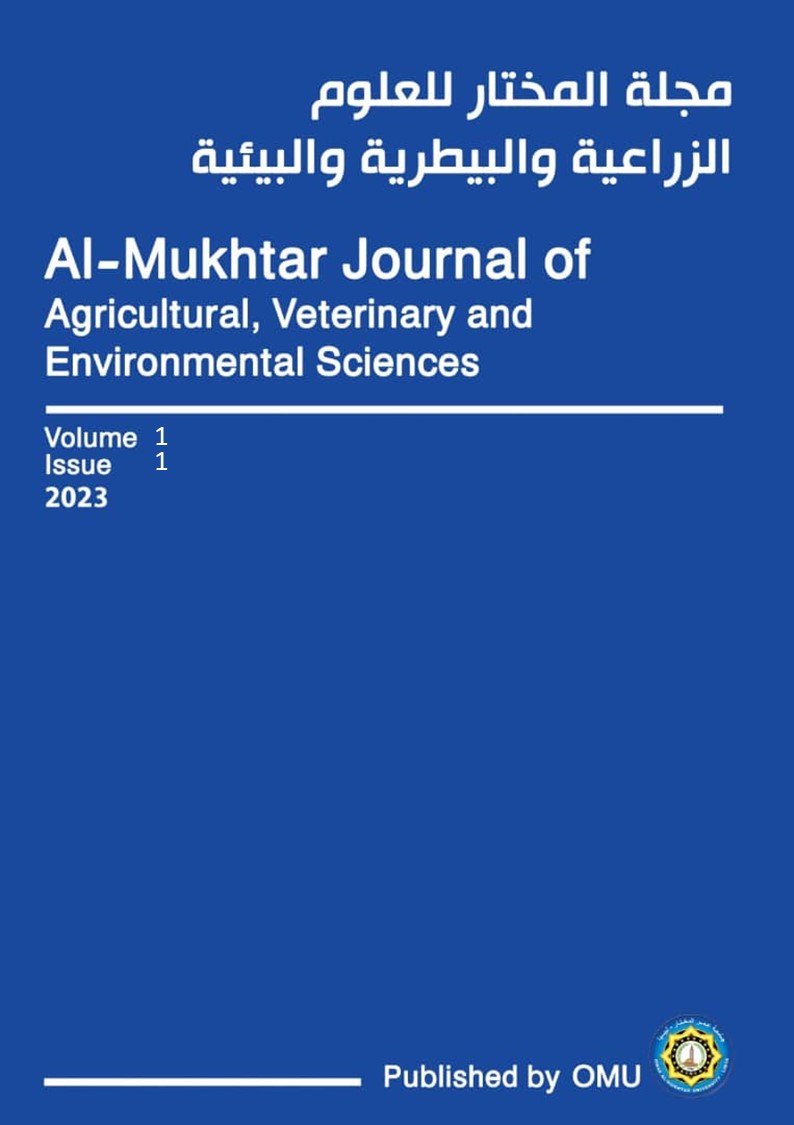Clinical Changes Evaluations in Amphotericin B Induced Osteoarthritis in Canine Models
DOI:
https://doi.org/10.54172/0hdbtq27Keywords:
Dogs, Stifle joint, Amphotericin B, Osteoarthritis, Canine ModelsAbstract
The experimental model of osteoarthritis (OA) was replicated in Six dogs induced osteoarthritis by intra-articular injection with amphotericin B (AB) in the left stifle joints. Right joints served as control. Medical status and certain goniometric parameters were tracked prior to the initiation of AB and on the 30th, 60th and 90th days after injection. The findings showed compellingly that the OA model used by the experimental chemical effectively replicated the disease in the stifle joints in dogs and showed a progressive disease progression, just as it does in the reported cases of arthritis that naturally affects dogs depending on the time of inflammation. Medical indications studied were associated with the seriousness of the disease.
References
Ashraf. abdel-hamed. Hegazi, & Khaled. M. A. Hussin. (2008). Diagnosis of joint affection in camels by studies on synovial fluid which give the degree of affections & response to treatment. Al-Mukhtar Journa of Sciences, 20(1), 58-72.
Bove, S., Calcaterra, S., Brooker, R., Huber, C., Guzman, R., Juneau, P., & Kilgore, K. (2003). Weight bearing as a measure of disease progression and efficacy of anti-inflammatory compounds in a model of monosodium iodoacetate-induced osteoarthritis. Osteoarthritis and cartilage, 11(11), 821-830.
Budsberg, S. C., Johnston, S. A., Schwarz, P., DeCamp, C. E., & Claxton, R. (1999). Efficacy of etodolac for the treatment of osteoarthritis of the hip joints in dogs. Journal of the American Veterinary Medical Association, 214(2), 206-210.
Clements, D. N., Carter, S. D., Innes, J. F., Ollier, W. E., & Day, P. J. (2006). Analysis of normal and osteoarthritic canine cartilage mRNA expression by quantitative polymerase chain reaction. Arthritis research & therapy, 8(6), 1-9.
Cross, A. R., Budsberg, S. C., & Keefe, T. J. (1997). Kinetic gait analysis assessment of meloxicam efficacy in a sodium urate-induced synovitis model in dogs. American Journal of Veterinary Research, 58(6), 626-631.
Fahmy, A., Hegazy, A., Abdelhamied, M., Shamaa, A., & Schimke, E. (1994). Clinical, Biochemical and Histopathological studies on arthritis in equine. The Veterinary Medical Journal-Giza, 42(1), 305-320.
Gordon, W. J., Conzemius, M. G., Riedesel, E., Besancon, M. F., Evans, R., Wilke, V., & Ritter, M. J. (2003). The relationship between limb function and radiographic osteoarthrosis in dogs with stifle osteoarthrosis. Veterinary Surgery, 32(5), 451-454.
Grisneaux. Emmanuelle, Pibaro., P., Dupuis. Jacques, & Blais. Diane. (1999). Comparison of ketoprofen and carprofen administered prior to orthopedic surgery for control of postoperative pain in dogs. Journal of American Veterinary Medical Association, 215(8), 1105-1110.
Harvey, V. L., & Dickenson, A. H. (2009). Behavioural and electrophysiological characterisation of experimentally induced osteoarthritis and neuropathy in C57Bl/6 mice. Molecular pain, 5(1), 1-11.
Hyytiäinen, H. (2015). Developing a physiotherapeutic testing battery for dogs with stifle dysfunction (Publication Number 2342-3161 ) University of Helsinki]. Published in Dissertationes Scholae Doctoralis Ad Sanitatem Investigandam.
Johnson, C. I., Argyle, D. J., & Clements, D. N. (2016). In vitro models for the study of osteoarthritis. The Veterinary Journal, 209, 40-49.
Knazovicky, D., Helgeson, E. S., Case, B., Thomson, A., Gruen, M. E., Maixner, W., & Lascelles, B. D. X. (2017). Replicate effects and test–retest reliability of quantitative sensory threshold testing in dogs with and without chronic pain. Veterinary anaesthesia and analgesia, 44(3), 615-624.
Kotschwar, J. L., Coetzee, J., Anderson, D., Gehring, R., KuKanich, B., & Apley, M. (2009). Analgesic efficacy of sodium salicylate in an amphotericin B-induced bovine synovitis-arthritis model. Journal of dairy science, 92(8), 3731-3743.
Kraus, V. B., Blanco, F. J., Englund, M., Karsdal, M. A., & Lohmander, L. S. (2015). Call for standardized definitions of osteoarthritis and risk stratification for clinical trials and clinical use. Osteoarthritis and cartilage, 23(8), 1233-1241.
Lascelles, B. D. X., Dong, Y.-H., Marcellin-Little, D. J., Thomson, A., Wheeler, S., & Correa, M. (2012). Relationship of orthopedic examination, goniometric measurements, and radiographic signs of degenerative joint disease in cats. BMC veterinary research, 8(1), 1-8.
Marttinen, P. H., Raulo, S. M., Suominen, M. M., & Tulamo, R. M. (2006). Changes in MMP‐2 and‐9 Activity and MMP‐8 Reactivity After Amphotericin B Induced Synovitis and Treatment with Bufexamac. Journal of Veterinary Medicine Series A, 53(6), 311-318.
Mathews, K., Kronen, P. W., Lascelles, D., Nolan, A., Robertson, S., Steagall, P. V., . . . Yamashita, K. (2014). Guidelines for recognition, assessment and treatment of pain: WSAVA Global Pain Council members and co‐authors of this document. Journal of Small Animal Practice, 55(6), E10-E68.
Millis, D. L., & Levine, D. (1997). The role of exercise and physical modalities in the treatment of osteoarthritis. Veterinary clinics of north america: small animal practice, 27(4), 913-930.
Mokkink, L. B., Terwee, C. B., Patrick, D. L., Alonso, J., Stratford, P. W., Knol, D. L., . . . de Vet, H. C. (2010). The Cosmin study reached international consensus on taxonomy, terminology, and definitions of measurement properties for health-related patient-reported outcomes. Journal of clinical epidemiology, 63(7), 737-745.
Muir, W. W., Wiese, A. J., & Wittum, T. E. (2004). Prevalence and characteristics of pain in dogs and cats examined as outpatients at a veterinary teaching hospital. Journal of the American Veterinary Medical Association, 224(9), 1459-1463.
Stokes, E. K. (2010). Rehabilitation outcome measures; New York: Churchill Livingstone; . The Veterinary Journal, 139, 43-45.
Williams, M. D., Kirkpatrick, A. E., Griffith, E., Benito, J., Hash, J., & Lascelles, B. (2014). Feasibility and repeatability of thermal quantitative sensory testing in normal dogs and dogs with hind limb osteoarthritis-associated pain. The Veterinary Journal, 199(1), 63-67.
Wiseman, M., Nolan, A., Reid, J., & Scott, E. (2001). Preliminary study on owner-reported behaviour changes associated with chronic pain in dogs. The Veterinary Record, 149(14), 423-424.
Downloads
Published
License
Copyright (c) 2023 Rehab Hamad, Asma Elmabrok, Hassan Hamad, Khaled Hussin (Author)

This work is licensed under a Creative Commons Attribution-NonCommercial 4.0 International License.













